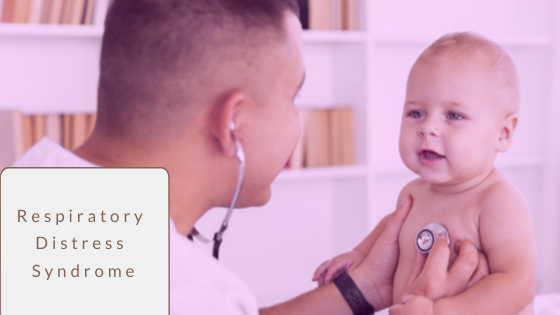Respiratory distress syndrome (RDS) is a condition where babies born prematurely or who suffer from certain lung conditions struggle to breathe. RDS occurs when fluid builds up in the lungs, causing them to become stiff and inflexible. This makes breathing very difficult.
Respiratory distress syndrome is caused by a lack of oxygen reaching the body's tissues. The baby's lungs are unable to expand fully during breathing, resulting in low blood flow to the lungs.
What are the types of RDS?
Respiratory distress syndrome is a condition that occurs in neonatal or pediatric patients, it is an increased amount of respiratory distress. There are three types of this disorder:
• Acute respiratory distress syndrome
• Chronic respiratory distress syndrome
• Cystic fibrosis
• Nephrotic syndrome
• Congenital heart defects
Acute respiratory distress syndrome
Acute respiratory distress syndrome is a medical condition that is characterized by severe damage to the lungs and breathing.
There are many causes of ARDS such as pneumonia, pulmonary edema, aspiration of blood or stomach contents, near drowning, sepsis, and other major infections.
Chronic respiratory distress syndrome
Chronic respiratory distress syndrome, or CRDS, is a disease that's also known as chronic obstructive pulmonary disease. It's a lung condition that causes breathing difficulties like shortness of breath and wheezing. This is often caused by smoking cigarettes, air pollution, or dust from construction sites.
CRDS is an umbrella term for several respiratory conditions like chronic bronchitis, emphysema, and bronchiectasis. The cause of the condition can vary from person to person.
Cystic Fibrosis
Cystic fibrosis is a chronic genetic disease that affects the lungs, liver, and pancreas.
Symptoms of Cystic Fibrosis
Some symptoms of cystic fibrosis are coughing up mucus, wheezing and shortness of breath, very salty-tasting skin (due to high salt levels in sweat), and poor growth.
Cystic fibrosis is caused by inherited mutations in the cystic fibrosis transmembrane conductance regulator (CFTR) gene. The CFTR gene makes a protein that regulates how salt and water pass in and out of cells in many organs. People with cystic fibrosis usually have two defective copies of the CFTR gene: one from each parent.
Nephrotic syndrome
Nephrotic syndrome is a disease that is characterized by a gradual, progressive loss of protein in the body. The main symptom of nephrotic syndrome is swelling caused by a protein that accumulates abnormally in connective tissues and organs.
Some causes of nephrotic syndrome are:
1) Autoimmune conditions like lupus and scleroderma
2) Kidney damage from diabetes or other chronic diseases
3) Excess blood clotting
4) Certain bacterial infections
5) Serious viral infections such as HIV, hepatitis B or C, or certain viruses that may cause myositis.
What causes respiratory distress syndrome?
Respiratory distress syndrome occurs when the respiratory tract is inflamed. This can happen for a variety of reasons, but it is usually due to inflammation of the trachea or bronchi.
The condition happens when there is too much mucus in the lungs, and the mucus builds up and blocks the airways. Those who have it will experience shortness of breath or labored breathing as a result. It can also lead to coughing and chest tightness.
Respiratory distress syndrome may be caused by any number of things from infection to asthma, allergies, COPD, or other lung diseases like pneumonia.
Get treated for your newborns by consulting with Neonatologists.
The most common symptoms of respiratory distress syndrome include:
- Shortness of breath
- Difficulty breathing
- Chest tightness or pain
- Coughing or wheezing
Who is most at risk for RDS?
Respiratory distress syndrome (RDS) is a rare but serious disease of the lungs. It occurs in premature babies and children with an acute illness or injury, and it can occur in adults during an asthma attack or other conditions.
In general, RDS develops when a lung becomes inflamed, which results in severe shortness of breath, wheezing, and rapid breathing. The symptoms can start suddenly or develop over hours to days or weeks.
If you are at risk for RDS or have been diagnosed with it, here’s what you need to know:
You may not know if you have RDS because it may not cause any symptoms until later on.
You may have trouble breathing because your airways are inflamed and narrowed. This makes breathing harder and usually, leads to coughing fits as well.
The main risk factors are:
- Prematurity -babies born before 37 weeks gestation are at greater risk of developing respiratory distress syndrome
- Prolonged labor -babies born during prolonged labor may have difficulty breathing
- Low birth weight -if your baby weighs less than 5½ pounds (2 kilograms), he's more likely to experience respiratory distress syndrome
- Smoking during pregnancy - smoking increases the risk of respiratory distress syndrome for both mother and baby
How is RDS diagnosed?
Respiratory distress syndrome is diagnosed based on clinical signs and symptoms, as well as laboratory investigation. Respiratory distress syndrome can be differentiated from bronchopulmonary dysplasia (BPD) by both its time course and clinical score, with respiratory distress syndrome having a shorter period of severity than BPD in its duration and generally a lower risk of death.
Other differential diagnoses include: Pseudomonas spp.; fungal infection; generalized sepsis; pulmonary embolism; diaphragmatic hernia; congenital heart disease; congenital airway malformation/atresia; septic lung injury
General care advice for babies with RDS
General care advice for a baby with Respiratory Distress Syndrome is to keep the infant warm, as this will help deliver more oxygen-rich blood and also protect against possible infection.
Zone out of the room:
- Playing music,
- Using a sound machine,
- Rocking or swinging in a rocking chair,
- Shushing or other white noise.
Respiratory distress syndrome can be scary, but the neonatologist in Coimbatore who works with these babies is the best at helping them breathe normally.
Give your newborn the best chance at a healthy life by contacting a top NICU Hospital

Comments
Post a Comment